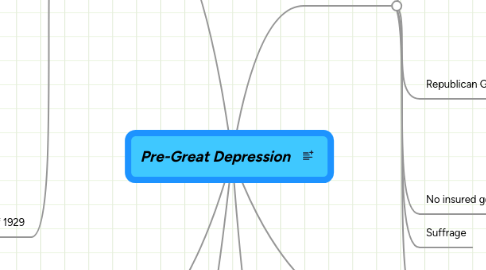
1. Economic
1.1. Crops are abundant
1.1.1. Demand for crops decreased
1.1.1.1. New node
1.1.1.1.1. New node
1.1.2. Prices lowered at grocery stores
1.1.3. Farmers could not make enough money
1.1.4. Farmers became bankrupts and lost land
1.2. Bank Failures
1.2.1. Sharp decline of international trade
1.2.1.1. Contraction of the money supply as bank loans are paid off
1.2.1.2. Debt liquidation and distress selling
1.2.1.3. A fall in the level of asset prices
1.2.1.4. A still greater fall in the net worths of business, precipitating bankruptcies
1.2.1.5. A fall in profits
1.2.1.6. A reduction in output, in trade and in employment.
1.2.1.7. Pessimism and loss of confidence
1.2.1.8. Saving of money
1.2.1.9. A fall in nominal interest rates and a rise in deflation adjusted interest rates
1.2.2. As banks failed, many surviving banks tightened up and gave out fewer and fewer loans, worsening the situation
1.2.3. Many people lost their savings in banks, as their savings were uninsured and vanished as banks failed
1.3. Stocks Market Crash of 1929
1.3.1. Businesses have a hard time making profit
1.3.2. People spend less
1.3.2.1. Less Production
1.3.2.2. Unemployment
2. Religious
2.1. American Protestantism
2.1.1. One side was mostly urban
2.1.1.1. Wanted change in religion
2.1.2. One side was fundamentalist
2.1.2.1. Believed in fighting to preserve traditional faith and to maintain the centrality of religion
3. Technology
3.1. Car
3.1.1. Bootlegging
3.1.2. Nascar
3.1.3. Daytona 500
3.2. Airplane
3.2.1. WWII
3.2.2. Transportation
3.3. New Weapons
3.3.1. Wars
3.4. Radio
3.5. Medication
3.5.1. Isulin
3.5.2. Antibiotics
3.6. Television
4. Political
4.1. Divided Democrats
4.1.1. Different interest groups
4.1.1.1. Prohibitionists
4.1.1.2. Klansmen
4.1.1.3. Fundamentalists
4.1.1.4. Catholics
4.1.1.5. Urban workers
4.1.1.6. Immigrants
4.1.2. Urban Democrats
4.1.2.1. Supported Alfred E. Smith (gov. of NY)
4.1.2.1.1. Secured the party's nomination for president
4.1.2.1.2. Was not able to unite his divided party due to widespread anti-Catholic sentiment
4.1.3. Rural Democrats
4.1.3.1. William McAdoo (Woodrow Wilson's Treasury Secretary
4.1.3.1.1. Supported Southern and Western delegates suspicious of modern urban life
4.2. Republican Government
4.2.1. Harding (president in 1920, senator from Ohio)
4.2.1.1. Teapot Dome Scandal
4.2.1.2. Harding transferred control of those reserved from the Navy Department to the Interior Department
4.2.1.3. Fall then secretly leased them to two wealthy businessmen and received in return nearly half a million dollars in loans to ease his private financial troubles
4.2.2. Coolidge
4.3. No insured government
4.4. Suffrage
4.5. Prohibition
4.5.1. Loss of jobs
4.5.2. Nationally Expensive
4.5.3. Created organized Crime
5. Social
5.1. Migration- Americans moving west
5.2. Immigration
5.2.1. National Origins Act of 1924
5.2.2. Banned immigration from East Asia
5.2.3. Reduced the quota in Europe to 2%
5.3. Rise of the New Klan
5.3.1. Concerned with Intimidating Catholics, Jews, and Foreigners
5.3.2. 4 million members
5.3.3. Used brute force (whipping, feathering, tarring)
6. Weather
6.1. Drought Conditions in Mississippi Valley
6.1.1. Many Farmers could not pay taxes
6.1.2. Had to sell farms
6.1.2.1. homeless
6.1.2.2. Did not know how to do anything else
6.1.2.3. No profit in selling farms
